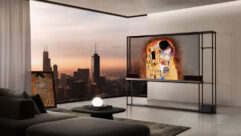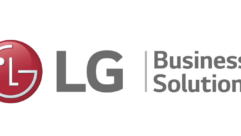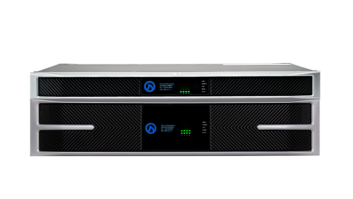At CES it was the year of the transparent displays. We’ve seen them before of course, but it went up a notch this time. From an AV standpoint the most noteworthy was probably the announcement of transparent conferencing displays. Not because they were so great (or shipping) but because it seemed like such an unnecessary application.
The displays are a partnership between LG and local-to-CES, Las Vegas-based company Veeo. Veeo makes behind-the-display camera technology designed to deliver the immediacy of eye contact.
The partnership will reportedly yield touch-enabled and gesture-controlled conferencing displays for summer release. The displays will be released under the name HoloDeck, with the “M” suffix denoting the presence of infrared sensors for touchscreen recognition, and the “T” suffix denoting the presence of gesture recognition (go figure on that naming convention). Pricing will range from approximately $2500 for the enclosed 30-inch touchscreen to $8500 for an unenclosed 55-inch clear glass, gesture-enabled screen.
In another attention-garnering partnership, LG built old school vacuum tubes into a. modern audio system then captured the whole thing inside a transparent OLED, like a firefly in a rectangular jar. LG says the transparency of the screen is adjustable to give viewers a peek at the insides or crank up the opacity to allow users to enjoy the ambiance of a crackling fireplace or even watch movies. They’re calling it the DukeBox and if pranking were a thing at CES, I would nominate this very meta insider AV contraption.
LG has been developing transparent OLED panels for awhile but CES saw a prototype debut of the company’s first ready-for-home product to incorporate the technology. It’s less eccentric than the other newsy debuts, and it’s lux to look at. Utilizing a transparent 4K OLED panel backed by a layer of contrast film, the 77-inch screen transparency can be manually adjusted from opaque to clear at will, while a Zero Connect box keeps the whole display completely wireless. So it’s like a work of modern sculpture that becomes a TV on demand. An “always on” feature allows users to showcase digital art or photos while the rest of the display “practically invisible” when turned off, says the marketing. Not really but, it’s still a classy kind of subtlety. For now, all of this is theoretical. LG has confirmed that the OLED Signature T will be available for purchase, but a retail date or price has not been provided. The company says it is still deciding on whether the TV will be available on its own, or only bundled with the decorative stand it was displayed with at CES.
Also on a little more real-world note, LG has expanded its transparent OLED sizes to add a 30-inch and a 77-inch.
Samsung also brought the transparency with the debut of what they’re calling the “world’s first transparent microOLED display.” It conjures the Pepper’s Ghost of my design era, though the tech press raved like they’d never seen anything like it. It’s brighter than a transparent LCD or OLED and has no bezel or frame.
The takeaway? Like the ghost of CES past, the transparent demos just get more dazzling, and always just out of reach.









